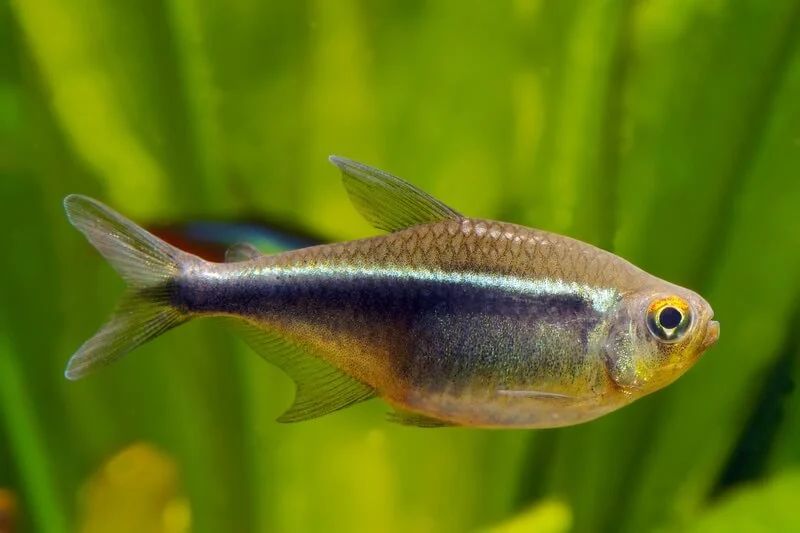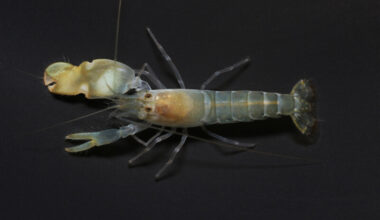Black Neon Tetras are a pretty and low-maintenance freshwater fish that all aquarists should consider. Because they’re a variation of an extremely popular species, they often get overlooked.
But in our opinion, these fish deserve more love! They’re easy to care for, have a unique look, and will get along with pretty much any other freshwater tank mates.
This guide will go into everything you need to know about Black Neon Tetra care. By the time you’re done reading it, you’ll be ready to own some yourself!
Table of Contents
Species Summary
No matter how experienced you are with fish-keeping, you’ve likely seen the traditional Neon Tetra at some point. The Black Neon Tetra (scientific name: Hyphessobrycon herbertaxelrodi) is a similar species that takes on a much darker appearance.
Considered to be the darker cousin of the Neon Tetra, these freshwater fish are equally as beautiful and easy to care for!

Black Neon Tetras come from the Paraguay Basin in Brazil. Their natural habitat spans several hundred kilometers. The fish can be found in small tributaries, floodplains, and rivers flowing through dense forests.
The specimens you see in the fish trade are largely captive-bred. Black Neon Tetras readily spawn in captivity, creating a healthy market for aquarists looking for a high-contrast fish for their tank.
Lifespan
The average Black Neon Tetra lifespan can reach up to 5 years in captivity. Their lifespan basically mimics regular Neons.
That said, there are no guarantees. While this species is known for its hardiness, failure to provide the basics could result in a dramatically shortened lifespan. To help your fish reach its full potential, you’ll need to provide the best environment, diet, and care possible.
Appearance
Black Neon Tetras are beautiful fish that stand out among natural decor. Like their brighter cousins, these fish are small and slender. They have a torpedo-shaped body with a rounded head and transparent fins.
The primary color of the Black Neon Tetra is relatively subdued. They often take on a slightly greenish hue. Complementing that base color is two vivid stripes.
The first is a thin stripe of iridescent white. It sparkles in the light to create a stunning glimmering effect. Directly below that stripe is a thicker band of black. This stripe is what lends the fish its name.
Both of the stripes run horizontally along the entire body of the fish. It runs from the gill cover down to the base of the tail fin.
Author Note: There are very minimal differences between males and females. Sexing the fish can be difficult. However, the easiest way to distinguish males and females is by looking at their bellies.
Females tend to have larger and more rounded bellies than females. This is especially true when the female reaches maturity and is ready for breeding.
Average Size
The average size of a full-grown Black Neon Tetra is usually around 1.5 inches in length. Sometimes specimens can reach 1.6 inches but that’s pretty uncommon.
Because of their small size, it can be hard to tell the difference between the large fish and smaller ones!
Black Neon Tetra Care
Black Neon Tetra care is relatively easy as long as you have the right information. This is no different from many of the other species in the tetra family.
This species tolerates a wide range of conditions and is pretty easy to please. This makes these fish great for beginners (or experienced aquarists looking for something low-maintenance).
As long as you provide the essentials, you should have no issues keeping these fish healthy. Below are some care guidelines you don’t want to miss!
Tank Size
At less than two inches long, you don’t need a massive tank for Black Neon Tetras. That said, these are schooling fish. It’s recommended that you keep a group of half a dozen together.
Even with a small group, these fish do fine with a tank size of at least 20 gallons.
Author Note: You can go bigger if you plan on keeping a multi-species community tank. Black Neon Tetras always appreciate the extra swimming space if its available.
Water Parameters
The bodies of water that Black Neon Tetras call home in the wild are unique. They’re not the crystal-clear lakes and rivers that most people envision. Instead, they are shallow streams filled with decaying plant matter!
Most Black Neon Tetras are found in tea-stained blackwaters. Fallen leaves cause the water to appear brown in color, which ultimately raises the acidity levels.
You can easily recreate that environment in your home aquarium. You don’t have to go so far as to stain the water, but you will need to stick to the following parameters:
- Water temperature: 68°F to 82°F (roughly 75 degrees is ideal)
- pH level: 5.0 to 7.5
- Water hardness: About 6 dGH
When you first introduce these fish to the aquarium it’s important to check the water more frequently. This transitional phase is when they’re more likely to suffer health complications as the result of shifting parameters.
Setting Up The Rest Of Their Tank
Creating a rich aquarium is key to keeping Black Neon Tetras healthy and happy. Recreating their natural environment will reduce stress while giving them an enriched life!
To do that, start with a sand substrate at the bottom of your tank.

Black Neon Tetras rarely venture to the bottom of the tank. They like to stick to the upper and middle parts of the water column. But, a sandy bottom is similar to what you’d find in their natural habitat.
Next, introduce live plants throughout the habitat. Choose a variety of different plants to create some thick vegetation in the background. Make sure to leave some open swimming space in the center!
To accompany those plants, add driftwood and rocks. All of that natural decor will serve as shelter from the light. Plus, it’ll become a place of exploration for the fish.
If you want to truly replicate the environment, place some plant leaves on the substrate. The leaves will release tannin, which will improve water quality for these fish and stain the water brown a bit.
Good filtration is a must, too. Black Neon Tetras don’t produce a ton of waste, but when kept in groups, that collective waste can have a major effect on ammonia and nitrate levels. So, use a powerful filter than can cycle the tank efficiently.
Author Note: Make sure that your filter produces a relatively strong flow near the top of the tank. Many owners like to add peat moss to the filtration system as well. This is said to bring out the coloration of the fish!
Disease Potential
They might be hardy, but Black Neon Tetras are not immune to disease. These fish can suffer from all of the same ailments as other tropical fish. This includes common health concerns like Ich, Dropsy, and more.
Luckily, those ailments are pretty easy to treat. Black Neon Tetras usually respond well to over-the-counter medications.
The best way to handle disease is to avoid it altogether. Maintain tank conditions and keep an eye on water parameters. Most diseases will affect fish once water conditions go south.
Replace up to 30-50 percent of the water every other week to keep things in good shape!

One important thing to remember about Black Neon Tetras is that they can easily carry diseases into your tank. This species is known to suffer from a disease called “Neon Tetra Disease.” Technically speaking, it’s a parasitic infection.
Fish will get this from other infected fish and spread it throughout the community. There is no known cure for it, so make sure that you’re getting healthy fish from a reputable source.
Food & Diet
Black Neon Tetras are natural omnivores. In the wild, they frequently feed on plant detritus, small crustaceans, and algae.
There are plenty of foods you can provide in captivity. A well-rounded diet will ensure that your fish are getting all the nutrients they need, which can improve coloration and appearance.
Dry flakes or pellets are a good start. You can then supplement this with brine shrimp, bloodworms, daphnia, mosquito larvae, and other protein-rich foods.
Author Note: Make sure not to overfeed these fish. Not only will this cause health complications due to them overeating, but it will also negatively impact the water quality in the aquarium.
Behavior & Temperament
Black Neon Tetras are gentle and passive. They don’t exhibit aggressive behavior at all. Even in groups, males usually aren’t territorial (behavior that is quite common with other species).
Speaking of groups, it’s very important to point out that Black Neon Tetras are schooling fish.
During the day, the group will explore the tank together. They often move in unison, creating a nice swathe of dark color around the tank!
While they do prefer to stay in groups, they are not totally dependent on each other. The group may break apart every once in a while so that the individual fish can hide out and relax.
Tank Mates
Because these fish are so small, you’ll need to choose tank mates that won’t eat them for lunch! Avoid any large or potentially aggressive fish. Keep the tank peaceful to avoid any injuries or accidents.
As we mentioned earlier, the best tank mates are going to be other Black Neon Tetras. At the very least, keep a group of six together. Any fewer and the fish might not have the confidence they need to swim around.
Other possible Black Neon Tetra tank mates you can consider are:
- Chili Rasbora
- Harlequin Rasbora
- Celestial Pearl Danio (other Danios are good too)
- Rummy Nose Tetra
- Neon Tetra (Green Neons as well)
- Small Freshwater Catfish
- Honey Gourami
- Dwarf Gourami
- Sparkling Gourami
- Pearl Gourami
- Freshwater Aquarium Snails
Author Note: It’s usually possible to keep Black Neon Tetras and Betta fish together. The color of this species tends to not trigger aggression in Bettas. Of course, you should always monitor the situation to make sure they don’t need to be separated (you never know).
Black Neon Tetra Breeding
Black Neon Tetras frequently breed in captivity. In many cases, spawning occurs naturally in the community tank.
To ensure the survival of the fish fry, we recommend setting up a separate breeding tank.
All you need is a small 10-gallon tank. Add dark sand substrate, plenty of plants, and subdued lighting. Then, introduce your bonded pair.
Condition the pair with live foods. Over the course of several days, slowly raise the temperature to about 80 degrees. This should trigger spawning.
The pregnant female will lay hundreds of eggs at once. She may scatter them onto the substrate or stick them on the underside of leaves. Whatever the case may be, the eggs will hatch in as little as 22 hours!
Before they hatch it’s important to remove the adults. They don’t show any parental instincts!
After the eggs hatch, wait for about three to four days. They will survive on their egg sac until they are large enough to eat. Then, provide baby brine shrimp or infusoria. Keep the babies in a separate tank until they grow close in size to the adults.
Closing Thoughts
Black Neon Tetra care is about as easy as it gets. These fish are a joy to own and can be owned by aquarists of all experience levels.
We hope you consider giving this species a shot. Even though many fishkeepers flock to their more popular relatives, these cute little fish have a lot to offer too!
As always, we’re more than happy to answer any of your questions if you reach out to us directly. There’s nothing we like more than chatting with our readers!

